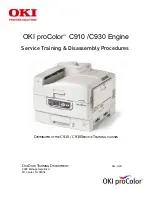
5–12
Interfaces
Signals
Host Clock / nWrite — Driven by host. Data transferred from host to printer. When
printer sends data, two types are available. If Nibble Mode, signal is set high. If
Byte Mode, signal is set low.
Data 1 through Data 8 — These pins are host–driven in Compatibility Mode and
bidirectional in Byte Mode. They are not used in Nibble Mode. Data 1 is the least
significant bit; Data 8 is the most significant bit.
Printer Clock / Peripheral Clock / Interrupt — Driven by the printer. A signal
from the printer indicating the character or function code has been received and
the printer is ready for the next data transfer.
Printer Busy / Peripheral Acknowledge / nWait — Driven by the printer.
Indicates the printer cannot receive data. (Data bits 4 and 8 in Nibble Mode.)
Acknowledge Data Request / nAcknowledge Reverse — Driven by the printer.
Indicates the printer is in a fault condition. (Data bits 3 and 7 in Nibble Mode.)
Xflag – Driven by the printer. A high true level indicating the printer is ready for
data transfer and the printer is on–line. (Data bits 2 and 6 in Nibble Mode.)
Host Busy / Host Acknowledge / NDStrobe — Driven by the host. Activates
auto–line feed mode.
Peripheral Logic High — Driven by the printer. When the line is high, the printer
indicates all of its signals are in a valid state. When the line is low, the printer
indicates its power is off or its signals are in an invalid state.
nReverse Request — Driven by the host. Resets the interface and forces a
return to Compatibility Mode idle phase.
nData Available / nPeripheral Request — Driven by the printer. Indicates the
printer has encountered an error. (Data bits 1 and 5 in Nibble Mode.)
1284 Active / nAStrobe — Driven by the host. A peripheral device is selected.
Host Logic High — Driven by the host. When set to high, the host indicates all
of its signals are in a valid state. When set to low, the host indicates its power is
off or its signals are in an invalid state.
nInit — Resets init interface from the host.
Summary of Contents for P5005A
Page 1: ......
Page 7: ...Contents iv...
Page 11: ...1 4 Introduction...
Page 175: ...4 122 Configuration Menus...
Page 193: ...5 18 Interfaces...
Page 215: ...A 10 Printer Specifications...
Page 216: ...Demand Printing B 1 B Demand Printing Overview B 2 Simple Tear B 3 Form Saver Mode B 5...
Page 223: ...C 2 ASCII Character Set...
















































